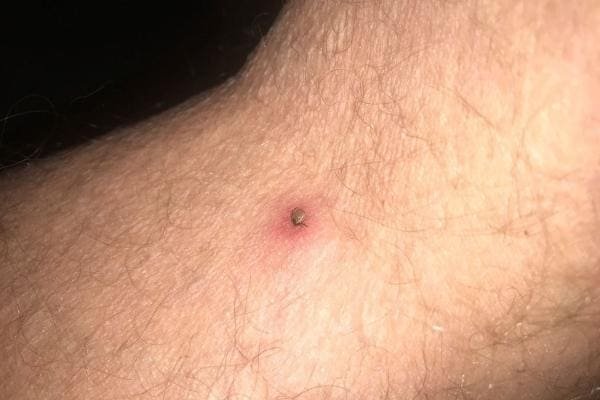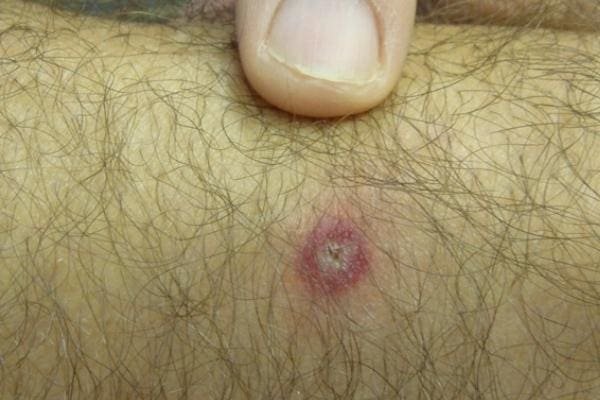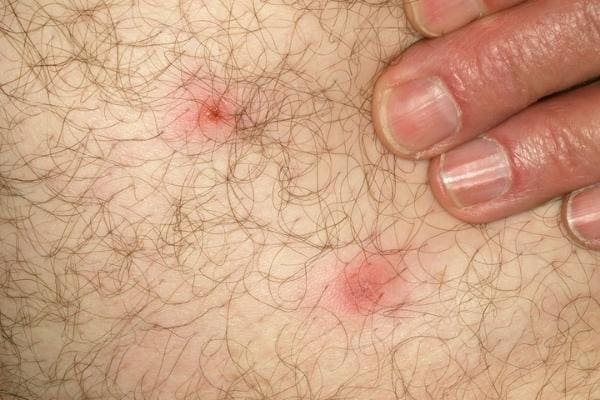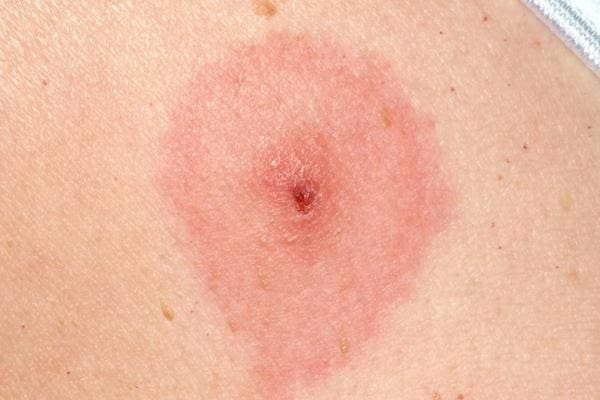
A few days after returning home from a hiking trip, you notice a small, red bump on your thigh. Not knowing exactly when or how it got there, you do some research and realize that it might be a tick bite.
Unlike most insects bites, tick bites don’t cause pain or itchiness—at least not right away. After all, ticks are very small to begin with and they also inject anesthetic into your skin as they feed. Once they’re full, they covertly detach themselves from your skin and wander off again.
So how can you tell if that mysterious insect bite was because of a tick or because of something else? In this article, we’ll explain what tick bites look like and share some pictures of tick bites.
What Does a Tick Bite Look Like?
The most obvious way to tell if a tick bit you is to see if the tick itself is still attached to your skin. If left undisturbed, ticks can stay attached to the host for anywhere between a few hours to several days.
A feeding tick looks like an engorged, oval-shaped bean stuck to your skin. Depending on it’s species, it can be black, brown, reddish-brown, gray, or yellow in color.
If you’ve found a tick still in the process of sucking your blood, read this article about how to safely remove it.

After the tick has detached itself, however, it’s a bit harder to tell. Tick bites can have several different appearances, depending on the type of tick that bit you as well as your own body’s reaction to the bite.
Most people have a localized skin reaction around the bite, leading to redness or mild swelling. Usually the size of the redness is no bigger than the size of a dime.
In some cases, certain people might develop allergic reactions to tick bites, which may lead to more significant swelling, redness, skin rashes, itchiness, and other symptoms.
Many people associate tick bites with the characteristic “bullseye” rash from Lyme disease, but in fact not all tick bites cause Lyme. We’ll talk about what some of these tick-borne diseases look like later in this article.

Tick bites sometimes come with a small puncture mark, where the tick embedded itself into your skin to feed. You might see a small, crusty, dry scab form around this puncture.
For an uninfected tick bite (in which no harmful bacteria or disease-causing microorganisms were transmitted), the amount of scabbing is typically pretty minimal and goes away within a few days. It’s part of the normal wound-healing process, and is more apparent when you’ve been bitten by a large tick.

Other times, depending on the size of the tick that bit you, the puncture mark may be too small to spot with the naked eye.
Adult ticks can vary in size from 2mm to 6mm, with the common blacklegged tick (deer tick) being on the smaller end—only about the size of a poppy seed. The head, which is the part of the tick that actually goes into your skin, is even smaller. Furthermore, the bite might also be from a tick larvae or nymph (yes, those can also bite).
If the puncture wound is too small to see, or has already healed, you’ll be left with only a small, red bump where the tick bit you.

The most common features that mark what a tick bite looks like (redness, mild swelling, and small puncture marks) are often confused for other mosquito bites, flea bites, or bed bug bites.
However, the appearance of tick bites become much more distinguishable when it comes to tick-borne diseases like Lyme disease.
But before we talk about what those look like, it’s important to note that not all tick bites transmit diseases. Only ticks carrying certain pathogens are able to do so. Even then, they usually need to be attached for quite some time before those pathogens can infect the host. For example, a tick needs to be attached for 36–48 hours before they can transmit the bacteria that causes Lyme disease, according to the CDC.
Bullseye Rash (Lyme Disease)
The bullseye rash, scientifically known as erythema migrans (EM), is the classic presentation of Lyme disease after being bitten by an infected deer tick. This rash usually appears between 3 to 30 days after the original bite.
It gets its name from the distinct pattern of red circles that appears on the skin around the tick bite. The rash develops as a circular red area that can be anywhere from 5–70 cm across.
In most cases, the middle part of the rash lightens in color as it expands, resulting in a red outer ring, a light-colored middle ring, and a smaller red circle in the center resembling a target with the bite as the bullseye.
It’s worth noting that this rash only appears in around 70–80% of people who contract Lyme disease. The exact pattern can also vary from person to person.
If you see a bullseye rash develop around your bite, seek immediate medical attention.



Rocky Mountain Spotted Fever
Another tick-borne disease with a very distinguishable appearance is Rocky Mountain spotted fever (RMSF).
As a result of an infected tick bite, RMSF presents as a rash characterized by small red splotches. Each red splotch is a flat, itchy skin lesion ranging from 1–5 mm in size.
These splotches start to appear around the original tick bite (usually after 2–4 days) and gradually spread to form a large area.

Other tick bite diseases can also lead to different appearances and symptoms, but Lyme disease and RMSF have the most distinguishable rashes. We’ll cover the common signs and symptoms of tick-borne diseases in another article.
About MMPC
At MMPC, we have over 25 years of experience helping New Yorkers keep ticks, mosquitoes, and other biting insects off your property with effective and eco-friendly pest control methods. If you have questions or need help with tick prevention, give us a call or contact us today!
